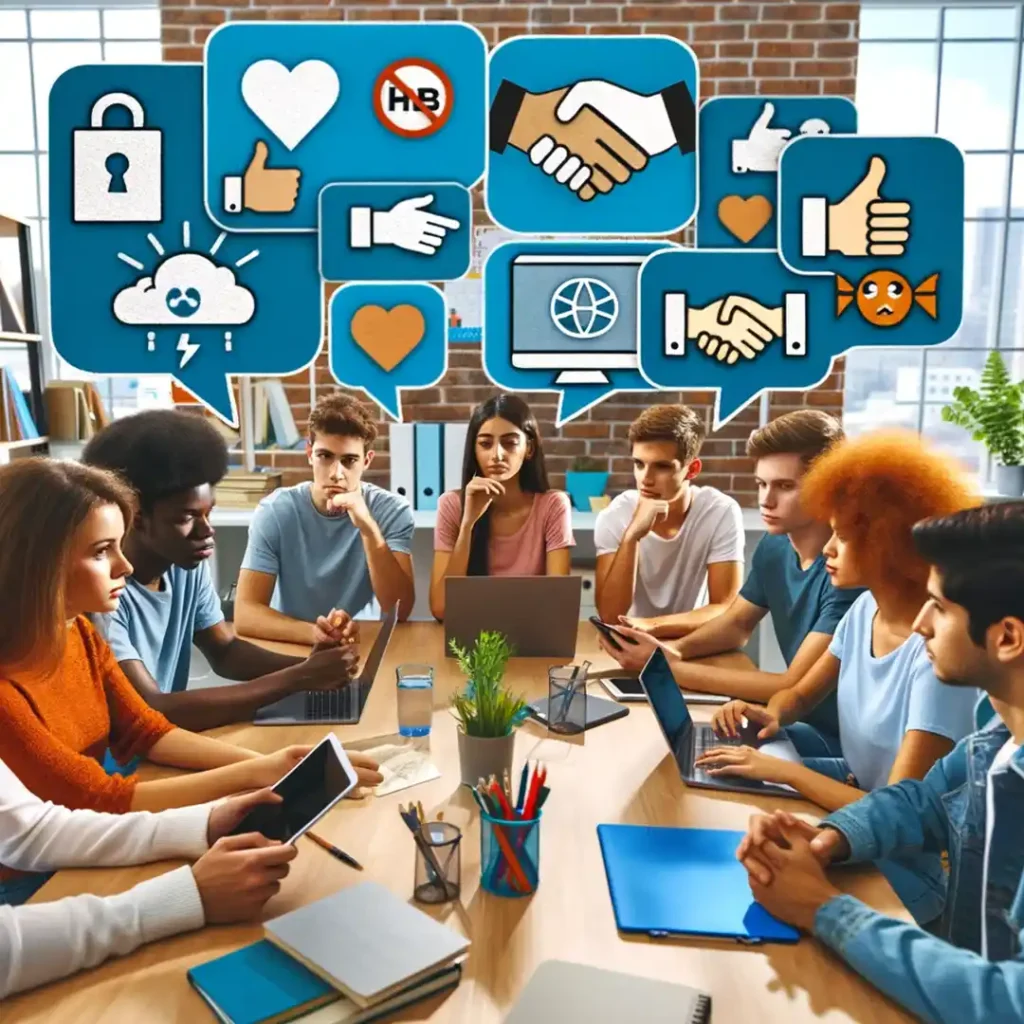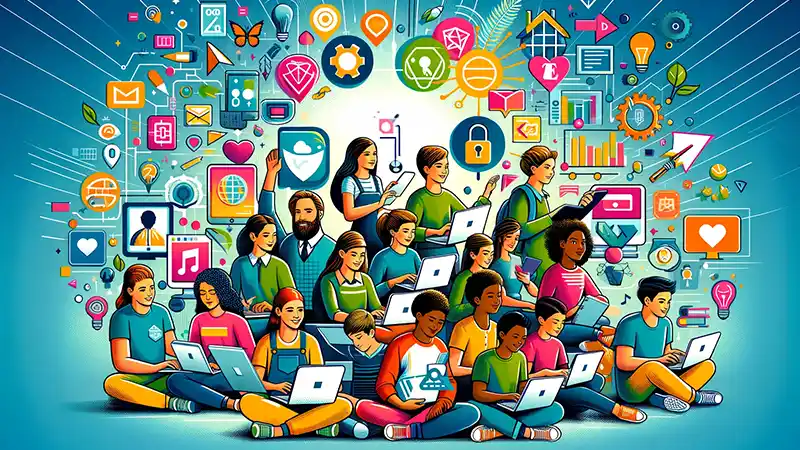the role of individuals extends far beyond mere responsible use of technology. As educators, it’s imperative to guide students not just in becoming adept digital citizens but also in emerging as digital leaders. This transition from digital citizenship to digital leadership is crucial in preparing students for a world where technology and leadership are intertwined.
In this article, we delve into 10 comprehensive lessons designed to facilitate this evolution. Each lesson focuses on a key aspect of digital citizenship and leadership, providing practical, engaging, and thought-provoking activities. Let’s embark on this transformative journey.
Lesson 1: Understanding Digital Citizenship
Objective: Students will understand the concept of digital citizenship, learn its core principles, and recognize their responsibilities in the digital world.
Duration: 1 hour
Materials Needed:
- Computer and projector for presentations
- Whiteboard and markers
- Handouts on digital citizenship principles
- Case study examples (digital scenarios)
Lesson Structure:
Introduction (10 minutes)
- Begin with a question: “What do you think digital citizenship means?”
- Briefly introduce the concept of digital citizenship.
Defining Digital Citizenship (15 minutes)
- Presentation on the definition of digital citizenship.
- Discuss its importance in today’s digital world.
- Interactive Q&A to ensure understanding.
Core Principles and Responsibilities (20 minutes)
- Introduce core principles such as digital literacy, digital etiquette, digital law, digital rights & responsibilities, and digital health & wellness.
- Use real-life examples to illustrate each principle.
- Group activity: Divide students into small groups and assign each group a principle to discuss and present.
Case Studies and Role-Playing (10 minutes)
- Present short case studies or scenarios that involve digital citizenship dilemmas.
- Have students role-play the scenarios to find solutions or demonstrate appropriate behavior.
Conclusion and Reflection (5 minutes)
- Summarize key takeaways.
- Encourage students to reflect on how they can apply these principles in their own digital lives.
Assessment:
- Participation in discussions and group activities.
- Short quiz or reflective essay on the importance of being a responsible digital citizen.
Follow-up:
- Assign students to create a digital poster or a short video on one aspect of digital citizenship to share with the class in a future session.
Lesson 2 - Ethical Online Behavior
Objective: Students will learn about ethics in the digital world, understand the importance of ethical behavior online, and apply their knowledge through case studies and role-playing activities.
Duration: 1 hour
Materials Needed:
- Computer with Internet access and a projector for presentations
- Whiteboard and markers
- Handouts with guidelines on ethical online behavior
- Prepared case studies depicting various online scenarios
- Role-playing activity instructions
Lesson Structure:
Introduction (10 minutes)
- Start with a discussion prompt: “What do you think ethical behavior means in the context of the internet?”
- Brief introduction to ethics in the digital world.
Discussing Ethics in the Digital World (15 minutes)
- Presentation covering key aspects of online ethics, such as respect, privacy, honesty, and responsible sharing.
- Discuss the consequences of unethical behavior online.
- Engage students in a Q&A session to clarify concepts.
Exploring Real-World Scenarios (20 minutes)
- Introduce various case studies that illustrate ethical dilemmas online (e.g., cyberbullying, sharing personal information, plagiarism).
- Divide students into small groups and assign each group a case study.
- Instruct each group to discuss their case study and propose solutions based on ethical principles.
Role-Playing Activities (10 minutes)
- Each group role-plays their scenario, demonstrating both unethical and ethical responses to the situation.
- Encourage class discussion on the outcomes of each approach.
Conclusion and Group Reflection (5 minutes)
- Summarize the key points learned about online ethics.
- Lead a reflective discussion on how students can apply ethical behavior in their digital interactions.
Assessment:
- Evaluate student participation in discussions and activities.
- Consider a brief quiz or a reflective writing assignment on the importance of ethical behavior online.
Follow-up:
- Encourage students to journal about an instance where they applied what they learned about ethical online behavior.
- Plan a future session to discuss the impact of their actions and any challenges they encountered.
Lesson 3: Online Safety and Privacy

Objective: Students will learn about online safety and privacy, including safe browsing practices and data protection strategies. They will also learn how to implement privacy measures to safeguard their information.
Duration: 1 hour
Materials Needed:
- Computer with Internet access and projector for presentations
- Whiteboard and markers
- Handouts on online safety tips and privacy measures
- Scenario-based activity worksheets
- Quiz or worksheet for assessment
Lesson Structure:
Introduction (10 minutes)
- Start with an engaging question: “Why is it important to be safe and private online?”
- Briefly outline the importance of online safety and privacy.
Teaching Safe Browsing and Data Protection (15 minutes)
- Present key concepts of safe browsing, such as avoiding suspicious links, understanding secure vs. insecure websites, and the importance of antivirus software.
- Discuss data protection strategies, including strong passwords, two-factor authentication, and being wary of sharing personal information.
- Use interactive Q&A to ensure students grasp the concepts.
Implementing Privacy Measures (15 minutes)
- Explain different privacy measures such as privacy settings on social media, understanding cookies and how to clear them, and using VPNs.
- Show practical examples of setting privacy measures on popular platforms.
- Discuss the consequences of not maintaining privacy online.
Scenario-Based Activity (15 minutes)
- Distribute scenario-based worksheets that depict various online situations where safety and privacy are at risk.
- Have students work in pairs or small groups to discuss and write down how they would handle each scenario.
- Share responses and discuss as a class, highlighting best practices.
Conclusion and Assessment (5 minutes)
- Summarize key takeaways on online safety and privacy.
- Distribute a quiz or worksheet to assess understanding of the lesson’s concepts.
Assessment:
- Participation and engagement in activities and discussions.
- Performance on the quiz or worksheet focusing on online safety and privacy principles.
Follow-up:
- Assign a project where students create a digital poster or a short presentation on online safety and privacy, to be shared in a subsequent class.
- Plan a review session in a few weeks to revisit and reinforce the concepts learned.
Lesson 4: Digital Footprint and Reputation
Objective: Students will understand the concept of a digital footprint and its impact on their reputation. They will learn how to audit and improve their online presence.
Duration: 1 hour
Materials Needed:
- Computer with Internet access and projector for presentations
- Whiteboard and markers
- Handouts on digital footprint concepts
- Worksheets for digital footprint auditing
- Case study examples
Lesson Structure:
Introduction (10 minutes)
- Begin with a discussion question: “What do you think a digital footprint is, and how might it affect you?”
- Provide a brief overview of the concept of a digital footprint and its long-term implications.
Explaining Digital Footprint (15 minutes)
- Present detailed information on what constitutes a digital footprint, including social media posts, online searches, app usage, and website visits.
- Discuss how digital footprints can impact personal reputation, future employment, and privacy.
- Engage students with examples and encourage them to think critically about their own digital footprints.
Auditing Online Presence (15 minutes)
- Guide students through the process of auditing their online presence. This can include checking social media settings, reviewing past posts, and understanding privacy policies.
- Distribute worksheets for students to perform a basic audit of their digital footprint in class.
- Encourage students to think about changes they might need to make to their online behavior.
Activities to Improve Online Presence (15 minutes)
- Introduce strategies for improving online presence, such as curating social media content, being mindful of post and comment language, and understanding the permanence of online actions.
- Discuss the importance of building a positive digital reputation for future opportunities, like college admissions and job searches.
- Interactive activity: Have students brainstorm and share ideas on how to positively build their digital footprints.
Conclusion and Reflection (5 minutes)
- Summarize the key learnings about digital footprints and their impact.
- Encourage students to reflect on their current digital footprint and how they plan to manage it moving forward.
Assessment:
- Evaluate students based on their participation in discussions and activities.
- Consider a follow-up assignment where students create a plan for managing their digital footprint.
Follow-up:
- Assign students to periodically review and update their digital footprint management plan.
- Plan a future session to discuss the progress and challenges students have encountered in managing their digital footprints.
Lesson 5: Critical Thinking in the Digital World
Objective: Students will learn how to evaluate online information critically, with a focus on identifying and understanding misinformation and fake news.
Duration: 1 hour
Materials Needed:
- Computer with Internet access and a projector for presentations
- Whiteboard and markers
- Handouts on evaluating online sources and spotting misinformation
- Examples of online articles, news stories, and social media posts (both credible and misleading)
- Worksheets for critical analysis exercises
Lesson Structure:
Introduction (10 minutes)
- Initiate with a question: “Why is it important to critically evaluate information we find online?”
- Briefly discuss the prevalence of misinformation and fake news in the digital age.
Evaluating Online Information (15 minutes)
- Present techniques for evaluating the credibility of online information, including checking the source, looking at the date, examining the evidence, and cross-referencing with other sources.
- Discuss the role of bias and perspective in how information is presented online.
- Engage students in a Q&A session to clarify these techniques.
Spotting Misinformation and Fake News (15 minutes)
- Provide examples of misinformation and fake news, explaining how they can be identified.
- Discuss the consequences of spreading false information.
- Interactive activity: Show students various news articles or social media posts and ask them to determine if they are credible or not, explaining their reasoning.
Critical Analysis Exercises (15 minutes)
- Hand out worksheets with different online statements or stories.
- Students work individually or in pairs to apply critical thinking skills to assess the credibility of each piece of information.
- Share and discuss answers as a class, highlighting key aspects of critical evaluation.
Conclusion and Reflection (5 minutes)
- Recap the importance of critical thinking in the digital world.
- Encourage students to reflect on how they can apply these skills in their daily interactions with online information.
Assessment:
- Participation in discussions and critical analysis exercises.
- A short quiz or reflective essay on the importance of critical thinking online.
Follow-up:
- Assign a project where students find an online news story or social media post and write a critical analysis of its credibility.
- Plan a session to review and discuss these analyses, focusing on the diversity of sources and perspectives.
Lesson 6: Collaborative Digital Projects

Objective: Students will learn how to use digital tools for effective collaboration in group projects. They will engage in planning and executing a collaborative digital project.
Duration: 1 hour (with additional time for project completion)
Materials Needed:
- Computers with Internet access for each student or group
- Projector for demonstrations
- List of digital collaboration tools (e.g., Google Docs, Slack, Trello)
- Handouts with guidelines for digital collaboration and group project ideas
- Rubric for project assessment
Lesson Structure:
Introduction (10 minutes)
- Start with a discussion: “What are some challenges and benefits of working on projects in a digital environment?”
- Introduce the concept of digital collaboration and its growing importance.
Using Digital Tools for Collaboration (15 minutes)
- Demonstrate various digital tools that facilitate collaboration, such as document sharing platforms, communication apps, and project management software.
- Discuss best practices for digital communication and teamwork.
- Engage students with a Q&A about the tools and practices.
Group Formation and Project Ideas (10 minutes)
- Divide the class into small groups.
- Present a list of potential digital project ideas (e.g., creating a digital presentation, designing a website, developing a digital marketing plan for a hypothetical product).
- Allow each group to select or propose a project idea.
Project Planning and Execution (20 minutes)
- Guide each group in creating a project plan, assigning roles, and setting deadlines.
- Have groups begin their projects, utilizing the digital collaboration tools introduced earlier.
- Circulate to provide guidance and ensure effective use of collaboration tools.
Conclusion and Next Steps (5 minutes)
- Recap the key points about digital collaboration.
- Discuss the next steps for the project completion and presentation in a follow-up session.
Assessment:
- Ongoing assessment of group collaboration and project progress.
- Final evaluation based on the completed project, using a provided rubric focusing on collaboration, creativity, and effective use of digital tools.
Follow-up:
- Schedule a session for project presentations.
- Plan a reflective discussion post-presentation to talk about what worked well and what challenges were encountered in digital collaboration.
Lesson 7: Empathy and Digital Communication
Objective: Students will learn the importance of empathy in digital communication. They will engage in activities designed to develop empathetic understanding and expression in online interactions.
Duration: 1 hour
Materials Needed:
- Computer with Internet access and projector for presentations
- Whiteboard and markers
- Handouts on empathy in digital communication
- Scenarios for role-playing activities
- Guidelines for discussion forums
Lesson Structure:
Introduction (10 minutes)
- Begin with an open question: “How do you feel when someone understands your feelings online, and why is it important?”
- Introduce the concept of empathy in digital communication, emphasizing understanding and sharing the feelings of others.
Encouraging Empathy in Online Interactions (15 minutes)
- Present the differences between empathy and sympathy, focusing on understanding others’ feelings rather than just feeling sorry for them.
- Discuss the importance of tone, language, and perspective-taking in online communication.
- Interactive Q&A to reinforce understanding.
Role-Playing Activities (15 minutes)
- Divide students into pairs or small groups.
- Distribute prepared scenarios that involve various online interactions, such as social media conversations, emails, or text messages.
- Have students role-play the scenarios, first without empathy and then with empathy, to highlight the differences in communication.
Discussion Forums (15 minutes)
- Organize a class forum where students can discuss topics related to empathy in digital communication.
- Encourage students to share personal experiences where empathy made a difference in digital interactions.
- Facilitate the discussion, ensuring a respectful and supportive environment.
Conclusion and Reflection (5 minutes)
- Summarize the key learnings about empathy in digital communication.
- Encourage students to reflect on how they can practice empathy in their own digital interactions.
Assessment:
- Evaluate student participation in role-playing and discussion activities.
- Consider a short reflective assignment where students describe how they can apply empathy in their future digital communications.
Follow-up:
- Assign an ongoing activity where students are encouraged to journal or share instances where they practiced empathy online.
- Plan a follow-up session to share experiences and discuss the impact of empathetic communication in digital spaces.
Lesson 8: Leadership Skills in Digital Contexts
Objective: Students will identify and develop leadership qualities in digital settings. They will explore examples of leadership in technology and learn how to apply these skills in their own digital interactions.
Duration: 1 hour
Materials Needed:
- Computer with Internet access and projector for presentations
- Whiteboard and markers
- Handouts on leadership qualities and digital leadership examples
- Profiles of leadership role models in technology
- Activity sheets for group discussions
Lesson Structure:
Introduction (10 minutes)
- Start with a question: “What qualities make a good leader in digital spaces?”
- Provide a brief overview of leadership in digital contexts, highlighting how it can differ from traditional leadership.
Identifying Leadership Qualities in Digital Settings (15 minutes)
- Discuss key leadership qualities such as communication, innovation, empathy, responsibility, and adaptability, and how they apply in digital contexts.
- Use interactive methods, like asking students for examples of these qualities in action online.
- Relate these qualities to digital collaboration, online problem-solving, and leading virtual teams.
Exploring Leadership Role Models in Technology (15 minutes)
- Present profiles of various leadership role models in the technology sector, focusing on how they demonstrate effective digital leadership.
- Discuss the impact of these leaders on technology and digital culture.
- Encourage students to share their thoughts on what makes these individuals effective leaders.
Group Discussion and Activity (15 minutes)
- Divide the class into small groups.
- Distribute activity sheets with scenarios requiring digital leadership skills (e.g., leading an online project team, moderating an online community).
- Have each group discuss and plan how they would handle the scenario using the leadership qualities discussed.
Conclusion and Personal Reflection (5 minutes)
- Summarize the key points about digital leadership qualities and role models.
- Encourage students to reflect on how they can develop and apply these skills in their own digital interactions.
Assessment:
- Evaluate participation in group discussions and the quality of responses to the activity scenarios.
- Consider a short written reflection or a presentation on a leadership role model in technology that inspires them.
Follow-up:
- Assign a project where students take on a leadership role in a small digital project, such as organizing a virtual event or leading an online discussion.
- Plan a session to debrief and discuss the challenges and successes of their leadership experiences.
Lesson 9: Impact of Digital Innovation

Objective: Students will explore how digital leaders shape society through innovation. They will engage with case studies of significant digital innovations to understand their societal impact.
Duration: 1 hour
Materials Needed:
- Computer with Internet access and projector for presentations
- Whiteboard and markers
- Handouts on key digital innovations and their leaders
- Case studies of notable digital innovations
- Worksheets for group activities
Lesson Structure:
Introduction (10 minutes)
- Begin with a thought-provoking question: “How do you think digital innovations have changed our world?”
- Briefly introduce the concept of digital innovation and its impact on society.
Exploring How Digital Leaders Shape Society (15 minutes)
- Discuss the role of digital leaders in driving innovation and societal change.
- Highlight key characteristics of these leaders, such as vision, creativity, and perseverance.
- Present examples of how digital leaders have addressed societal challenges or opened new opportunities.
Case Studies of Digital Innovation (20 minutes)
- Introduce several case studies of digital innovation. These could include stories behind major technological advancements, startups that have become influential, or digital solutions to global problems.
- Encourage students to analyze the impact of these innovations on society, economy, and culture.
- Facilitate a discussion on the potential future implications of these innovations.
Group Activity: Analyzing Innovation (10 minutes)
- Divide students into small groups and assign each group a specific innovation case study.
- Provide worksheets for groups to analyze their assigned innovation in terms of its development, impact, and the leadership behind it.
- Have each group present their findings, focusing on the innovation’s societal impact.
Conclusion and Reflection (5 minutes)
- Recap the key insights gained about the impact of digital innovation.
- Encourage students to reflect on how they can contribute to positive societal change through digital innovation.
Assessment:
- Participation and engagement in group discussions and presentations.
- A reflective assignment or quiz based on the case studies and concepts discussed.
Follow-up:
- Assign a research project where students explore a recent digital innovation and its impact, presenting their findings in a future class.
- Plan a session to discuss the ongoing developments in digital innovation and their potential future impacts.
Lesson 10: Becoming a Digital Leader
Objective: Students will learn practical steps to become digital leaders. They will create a personal project titled “My Digital Leadership Plan” to apply these concepts to their aspirations and context.
Duration: 1 hour (with additional time for project completion)
Materials Needed:
- Computer with Internet access and projector for presentations
- Whiteboard and markers
- Handouts on the qualities and skills of digital leaders
- Templates for “My Digital Leadership Plan”
- Examples of digital leadership in various domains
Lesson Structure:
Introduction (10 minutes)
- Start with a question: “What qualities do you think are important for a digital leader?”
- Briefly discuss the evolving role of leadership in the digital age.
Practical Steps to Become a Digital Leader (15 minutes)
- Present key qualities of digital leaders, such as vision, adaptability, empathy, and technical know-how.
- Discuss practical steps to develop these qualities, including continuous learning, engaging with technology, and networking.
- Encourage students to think about how these steps are applicable in their current and future endeavors.
Exploring Examples of Digital Leadership (15 minutes)
- Show examples of successful digital leaders from various fields, highlighting their achievements and leadership styles.
- Discuss how these leaders have used digital tools and platforms to influence, innovate, and inspire.
- Facilitate a discussion on the diverse ways to exhibit leadership in the digital realm.
Personal Project: My Digital Leadership Plan (15 minutes)
- Introduce the personal project: creating a “My Digital Leadership Plan.”
- Provide templates and guidelines for the plan, which should include personal goals, steps to develop digital leadership skills, and a timeline.
- Allow time for students to start working on their plans, offering guidance and answering questions.
Conclusion and Next Steps (5 minutes)
- Summarize the key points about becoming a digital leader.
- Discuss the importance of personal initiative and continuous growth in the journey to digital leadership.
Assessment:
- Evaluate the “My Digital Leadership Plan” for thoughtfulness, realism, and clarity.
- Consider peer reviews or presentations of their plans for added insight and feedback.
Follow-up:
- Schedule a session for students to present their digital leadership plans and discuss their progress.
- Plan periodic check-ins or a follow-up project where students can share updates and adapt their plans based on new learnings and experiences.
Conclusion
As we conclude this exploration into the realm of digital leadership and its various facets, it’s important to reflect on the key learnings we’ve gathered. From understanding the essence of digital citizenship, embracing ethical online behavior, ensuring online safety and privacy, to recognizing the impact of our digital footprint, each lesson has been a stepping stone towards becoming proficient in navigating the digital world. We delved into the nuances of critical thinking in digital contexts, harnessed collaborative tools for effective teamwork, and embraced empathy in our digital communications. Moreover, we looked at leadership skills in digital contexts and the transformative power of digital innovation.

